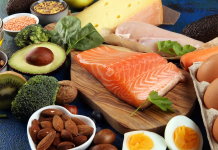Find out how much carbohydrate, protein and fat you should be eating and when. Choose wisely for a healthy diet that keeps you full around the clock.
Men have different daily nutritional requirements to women and, below, our nutritionist has offered guidance and recipe ideas for men seeking a balanced diet for good health. But what exactly is a ‘balanced diet’?
The Eatwell Guide defines the different types of foods we should be eating and in what proportions. The guide explains some simple rules to follow like getting a minimum five-a-day of fruit and veg, including wholegrains and choosing more fish, poultry, beans and pulses, less red meat and lower fat, lower sugar dairy (or dairy-free alternatives). But that’s not the whole story. How much should you be eating and is there an ideal time to eat protein, carbs or fats? Read on for our guide to healthy eating around the clock.
Reference Intakes (RI)
Nutritional needs vary depending on sex, size, age and activity levels so use this chart as a general guide only. The chart shows the Reference Intakes (RI) or daily amounts recommended for an average, moderately active adult to achieve a healthy, balanced diet for maintaining rather than losing or gaining weight. The RIs for fat, saturates, sugars and salt are all maximum amounts, while those for carbs and protein are figures you should aim to meet each day. There is no RI for fibre although health experts suggest we have 30g a day.
Reference intakes (RI)
Men
Women
Energy (kcal)
2500
2000
Protein (g)
55
50
Carbohydrates (g)
300
260
Sugar (g)
120
90
Fat (g)
95
70
Saturates (g)
30
20
Salt (g)
6
6
Perfect portions
Numbers and figures are all very well, but how does this relate to you? Keeping the Eatwell Guide in mind, you can personalise your portion sizes with our handy guide.
Foods
Portion size
Carbs like cereal/rice/pasta/potato (include 1 portion at each main meal and ensure it fills no more than ¼ of your plate)
Your clenched fist
Protein like meat/poultry/fish/tofu/pulses (aim to have a portion at each meal)
Palm of your hand
Cheese (as a snack or part of a meal)
2 of your thumbs
Nuts/seeds (as a snack or part of a meal)
1 of your cupped hands
Butter/spreads/nut butter (no more than 2 or 3 times a day)
The tip of your thumb
Savouries like popcorn/crisps (as a snack/treat)
2 of your cupped hands
Bakes like brownies/flapjacks (as an occasional treat)
2 of your fingers
Don’t forget, as set out in the Eatwell Guide, we should all be aiming for a minimum of five portions of fruit and vegetables a day. Discover what counts as one portion using our five-a-day infographic.
Breakfast
Whether your first stop is the office or the gym, adding protein to your breakfast is a great way to rev up your metabolism. If you do exercise first thing, a protein breakfast helps promote muscle recovery and repair. Eggs are an ideal choice because they provide a good balance of quality protein and fat. Other options include lean ham, fish like salmon or haddock, as well as lower fat dairy or dairy-free alternatives. Protein foods slow stomach emptying, which means you stay fuller for longer so you’ll tend to eat fewer calories the rest of the day.
If you’re short of time in the morning a protein-rich breakfast needn’t take any longer. Top your morning toast with a couple of slices of smoked salmon, some lean ham or some scrambled eggs and when you do have a little more time, enjoy an omelette, frittata or our version of the full English.
Protein breakfast recipes:
Scrambled omelette toast topper
One-pan summer eggs
Flash-fried smoked salmon & egg bagel
Ultimate makeover full English
Full English frittata
All-in-one baked mushrooms
Full English potato cake
Mid-morning snack
Eating well in the morning is vital for balancing energy levels. The ideal is to eat little and often, but you need to make every snack work for you. This means choosing snacks that satisfy your energy needs plus supply extra benefits like topping up your five-a-day.
Try peanut butter and banana on crackers, or opt for creamy avocado with slices of turkey.
Energy-giving snacks:
Peanut butter & banana on toast
Turkey & avocado toast
Lunch
Make lunch a mix of lean protein and starchy carbs. Carb-rich foods supply energy so you’ll suffer from mid-afternoon slumps if you cut them out. The key is to choose carbs that produce a steady rise in blood sugar, which means passing on sugary ‘white’ foods and going for high-fibre wholegrains, which help you manage those afternoon munchies. Wholegrains like rye, wholewheat and barley keep you satisfied for longer. In fact studies show rye bread keeps blood sugar stable for up to 10 hours – a sure way to dampen those mid-afternoon energy crashes.
Opt for an open sandwich topped with lean beef or pork, salmon, turkey or chicken with plenty of salad or toast some wholegrain bread and enjoy with baked beans.
Protein and carb lunch recipes:
Mid-afternoon
For many it’s not sugar so much as salty, savoury foods they crave in the afternoon. If this sounds like you, forget the crisps and opt instead for spiced nuts, seeds and savoury popcorn, or enjoy lower fat cream cheese on crackers
Dinner
Don’t curfew carbs, they’re low in fat, fibre-rich and help you relax in the evening. Combine them with essential fats which your body can use overnight, along with protein, for regeneration and repair – this combination is especially important for healthy skin and hair. You can get these healthy fats from oily fish like salmon, trout and mackerel as well as nuts, seeds and their oils.
Fill half your plate with a colourful variety of vegetables or salad, drizzle with a dressing made from linseed or rapeseed oil and add meat, fish or beans with a serving of brown rice, quinoa or wholemeal pasta.



























